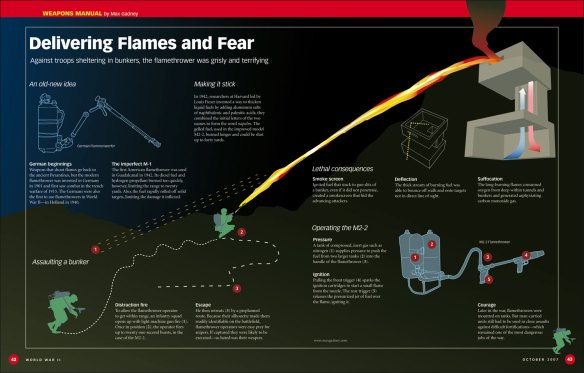As World War I bogged down in the trenches, each side sought a means of breaking the stalemate. Germany’s first attempt was a weapon developed in secret more than a decade earlier.
In 1901 Richard Fiedler rolled out a prototype of what he called a Flammenwerfer (“flamethrower”). Fiedler’s early design centered on a vertical tank divided into two compartments. The lower section held compressed gas, usually nitrogen, which forced flammable oil from the upper section through a rubber tube and past a simple ignition device in the steel nozzle. A stationary form of the weapon, the grosse Flammenwerfer, or Grof, was capable of throwing fire as far as 120 feet. Its smaller cousin the kleine Flammenwerfer, or Kleif, could project flames only half as far but was portable, small enough to be operated by two men.
The German army adopted the Kleif in 1906, and by 1912 the Guard Reserve Pioneer Regiment boasted its own regiment of Flammenwerfer troops. The weapon and its units largely remained a secret, however, until the Germans finally unleashed it at Verdun on Feb. 26, 1915. Shaking off their initial terror, the French counterattacked, retook the lost ground and managed to capture a Kleif, which its weapons researchers promptly disassembled.
At the Second Battle of Ypres, a half-dozen Kleif operators so terrified British soldiers on the night of July 29-30, 1915, that the Germans were able to capture several trench lines. But its material effectiveness seldom exceeded its psychological effect, as the fuel lacked a thickening agent to make it stick to its target-a shortcoming remedied by World War II. Regardless, the Allies soon developed their own versions of the weapon, canceling out what little advantage the Flammenwerfer had briefly granted its inventors.
Once adopted by the Germans, it was copied to a lesser extent by the French and British. The British Army, in particular expended much effort in attempting to develop large static flamethrowers for defensive purposes, but with little success. After the war it was quickly discarded, since most armies considered it to have been a specialized device for the peculiar conditions obtaining in the trench warfare in Flanders. It reappeared in Italian hands in the Abyssinian campaign of 1935, when a tank-mounted flamethrower was employed and also in small numbers in the Spanish Civil War, in both man pack and tank-mounted versions.
During the Second World War, the German army used flamethrowers in the Polish campaign and also in the advance into France and Belgium in 1940, particularly against the Belgian forts such as Eben Emael. After this, they saw little use since they did not fit in with the tactics of open war. The British Army, on the other hand, began development later in the war with the intention of using flame during assault operations against the coast of Europe.
